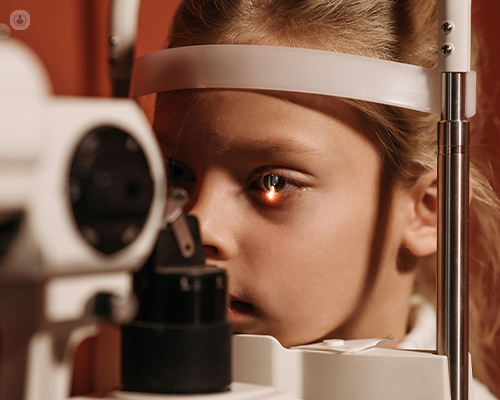Paediatric strabismus care: how orthoptists and vision therapy improve eye alignment
Escrito por:Strabismus, colloquially known as squint, is a condition where the eyes are misaligned – for example, when looking straight ahead, one eye may be fixed to the correct point, but the other could be turning inward, upward, downward, or outward. This disorder can be present in one eye or both and can be a constant or intermittent issue. Strabismus has several possible causes, which can occur later in life, or patients can be born with it (which is called congenital strabismus). In this article, a leading orthoptist shares how strabismus can be treated using vision therapy and orthoptics.

What is strabismus?
Strabismus in children is often caused by a muscular issue that causes irregular or unresponsive movement in the eyes. It can be genetic and run in families. Most children are diagnosed with strabismus when they are between one to four years old; it is normal for newborn infants to occasionally have crossed or wandering eyes as their system calibrates, but this normally stops around three months of age when they should be able to focus on small objects. Some children may not notice there is a problem with their eyes as they grow accustomed to the condition and it may only be noticed by the adults in their lives, but other children may complain of double vision, headaches, and difficulty reading. They may unconsciously try to accommodate their vision problems by squinting a lot or manoeuvring their heads for a better perspective.
Why is paediatric strabismus important to treat?
While not a dangerous condition, if left unaddressed in young patients, strabismus will become harder to correct as they age and can bar them from certain opportunities and activities or contribute to struggles with reading and schoolwork. Treating strabismus as soon as possible means that the patients and the orthoptists will have a far easier time implementing treatment programmes as their eyes are still developing and thus are malleable.
How is paediatric strabismus treated?
Orthoptics are focused specifically on improving the eyes’ muscles and alignment so that the eyes can work together effectively. A child with vision issues will likely see an orthoptist first before any other specialist, as they prioritise treatments without using surgery. To treat strabismus, they may recommend that the child undergo vision therapy.
Vision therapy (VT) is a non-surgical treatment programme of visual activities and stimuli to correct vision problems and strengthen visual abilities. These activities take the form of exercises, tests, filters, patching (occlusion), and lenses and prisms.
With VT, the associated struggles of strabismus – double or blurry vision, headaches, poor hand-eye coordination and depth perception, and focusing issues – can be corrected. VT has been proven particularly effective for a type of intermittent strabismus called convergence insufficiency, where the eyes skew out of alignment when reading or looking at objects up close despite normal alignment when looking at objects in the distance.
Each programme is designed especially for the patient and their needs – think of it as physical therapy but for the eyes, with weekly sessions of around an hour long and conducted under the supervision of an eye specialist or orthoptist.
If you believe your child may be struggling with strabismus, you can consult with a specialist on Top Doctors today.


